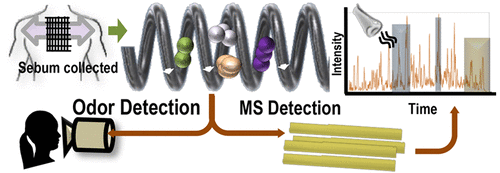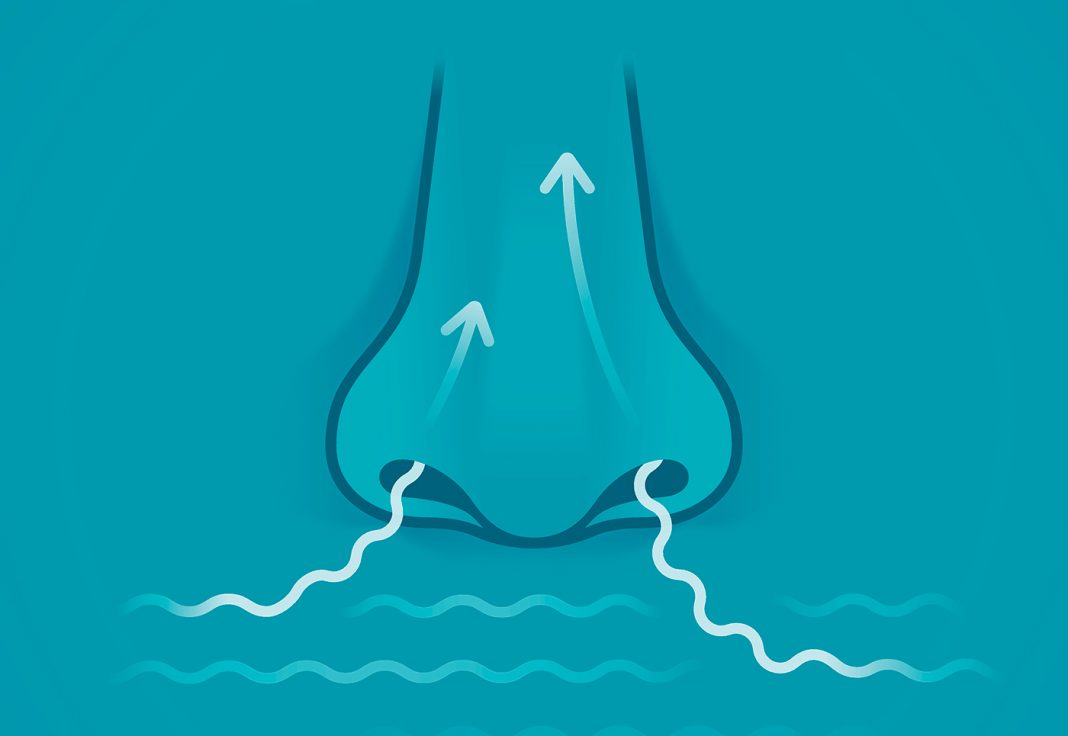Researchers in the U.K. have combined sophisticated chemical analyses with the help of a human “super smeller” who can sniff out Parkinson’s disease (PD), to identify volatile compounds in sebum on the skin that are part of the signature odor of the disorder, and which may represent biomarkers for early diagnosis.
Reporting their findings today in ACS Central Science, the team, headed by Perdita Barran, PhD, professor of mass spectrometry at the University of Manchester’s faculty of science and engineering, say that while their proof-of-principle study provides the “first description of the skin volatilome in PD compared to control subjects,” further larger-scale research that combines chemical analyses with the noses of human and canine smellers could help to establish a panel of volatile biomarkers for the disorder. This could then “open new avenues for stratification as well as facilitate earlier detection of PD and further the understanding of disease mechanisms,” the authors stated in their published paper, which is titled, “Discovery of volatile biomarkers of Parkinson’s disease from sebum.”

Flying in the face of scant scientific evidence, Joy Milne, a super smeller whose husband was diagnosed with PD in the 1980s, has demonstrated what the team described as “a unique ability” to detect PD by its smell. “Joy has an extremely sensitive sense of smell, and this enables her to detect and discriminate odors not normally detected by those of average olfactory ability,” the researchers explained. “Identification and quantification of the compounds that are associated with this distinctive PD odor could enable rapid, early screening of PD as well as provide insights into molecular changes that occur as the disease progresses and enable stratification of the disease in the future.”
Initial tests using swabs taken from various parts of the body suggested that this odor is present on parts of the skin that produce high levels of sebum, including the forehead and upper back, but not the armpits. Sebum is a waxy, lipid-rich biofluid that is excreted by the sebaceous glands in the skin and is, interestingly, sometimes overproduced in patients with PD.
Characteristic odors are the result of our olfactory system detecting substances in the air including volatile organic compounds (VOCs). “The term ‘volatilome’ describes the entirety of the volatile organic and inorganic compounds that may originate from any organism, or object, which may be analytically characterized,” the team continued. Measuring these volatile compounds can be carried out using a technique known as thermal desorption-gas chromatography-mass spectrometry (TD-GC-MS), in which an enclosed test sample is heated to release volatile components, and the headspace then captured and analyzed by GC-MS. It’s an approach that is “highly suitable for use in identifying the metabolites that give rise to the distinct scent of PD,” the team stated.
For their study, the team used the TD-GC-MS identified volatile compounds in sebum swabbed from the upper backs of 30 PD patients (including those on medication and drug-naïve individuals) and matched controls. Tests on this discovery cohort were then followed up by a second round of testing on samples from a completely separate, validation group of 31 PD patients and controls.
The resulting data indicated that hippuric acid, eicosane, and octadecanal, were among those volatile components found at greater concentrations in the sebum from PD participants compared with controls, which indicated altered levels of neurotransmitters in the PD patients. In contrast, levels of perillic aldehyde were lower in PD samples. There were no significant differences between PD participants on medication and drug-naïve PD patients.
Hooking up an odor port to the GC-MS instrument allowed Milne to give her verdict on the tests. She reported when any smell was present and also, more importantly, noted when she detected the distinctive “very strong” and “musky” smell of Parkinson’s disease. Her results, presented as an olfactogram, corresponded well with GC-MS detection of the volatile compounds that were characteristic of PD. “There was significant overlap between regions that contained up-regulated compounds and regions in which a smell similar or identical to that of PD scent was present,” the scientists stated. Milne was also able to confirm the characteristic smell of Parkinson’s disease when presented with samples that contained laboratory-prepared mixtures of the volatile compounds at different concentrations.
Combining data from the discovery and validation cohorts, the researchers were able to identify a signature of nine biomarkers that were changed in the sebum of PD participants. “The mixture of nine compounds was consistently described as being most akin to the PD-like odor … ” they commented. The team also acknowledged that while this combination of nine compounds may not be solely responsible for the unique smell of PD, they do at least contribute to it.
 The team suggested that larger scale studies will now be needed. “We do acknowledge that the current study is limited with smaller sample size, but the power of this study is a different validation cohort that consisted of completely different participants,” they pointed out. “ …our study highlights the potential of comprehensive analysis of sebum from PD patients and raises the possibility that individuals can be screened noninvasively based on targeted analysis for these volatile biomarkers … A larger study with extended olfactory data from human smellers as well as canine smellers in addition to headspace analyses is the next step in further characterizing the PD sebum volatilome.”
The team suggested that larger scale studies will now be needed. “We do acknowledge that the current study is limited with smaller sample size, but the power of this study is a different validation cohort that consisted of completely different participants,” they pointed out. “ …our study highlights the potential of comprehensive analysis of sebum from PD patients and raises the possibility that individuals can be screened noninvasively based on targeted analysis for these volatile biomarkers … A larger study with extended olfactory data from human smellers as well as canine smellers in addition to headspace analyses is the next step in further characterizing the PD sebum volatilome.”



